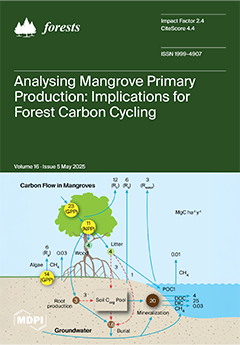The changes in soil nitrogen mineralization rate induced by litter input can determine the availability of nitrogen for plant growth in the soil. In forest ecosystems, the mixing of different species of litter can alter the chemical properties of the litter, ultimately affecting the rates of soil nitrogen transformation and cycling. In this study, litters with
Fraxinus mandshurica Rupr. and
Larix gmelinii (Rupr.) Kuzen. and mixed litter with
Fraxinus mandshurica and
Larix gmelinii were added to dark brown soil and incubated in the lab for 175 days at 25 °C. NH
4+-N and NO
3−-N contents and nitrogen mineralization rates were periodically measured to explore the effect of mixed litter addition on soil nitrogen mineralization. The results showed that compared to
Larix gmelinii litter,
Fraxinus mandshurica litter demonstrates higher carbon, nitrogen, and phosphorus contents while exhibiting lower lignin and cellulose contents and lower C/N and lignin/N ratios. Soil inorganic nitrogen content showed a trend of initial decrease followed by an increase. At the end of the incubation, soil NH
4+-N and NO
3−-N and the total inorganic nitrogen contents were 4.6–7.8 times, 2.2–3.4 times, and 2.9–4.3 times higher than the initial value, respectively. The soil nitrogen mineralization rate exhibited an initial rapid increase followed by stabilization. During days 7–28 of incubation, the nitrogen mineralization rates in litter addition treatments were lower than that in the control, while they were higher than that in the control during days 42–175. The soil nitrogen mineralization rate in the treatments with
Fraxinus mandshurica litter and mixed litter were higher than those in the treatment with
Larix gmelinii litter. The cumulative net nitrogen mineralization amounts in the
Fraxinus mandshurica litter and mixed litter treatments were higher than those in the
Larix gmelinii litter treatment, being 1.5 and 1.2 times those of the
Larix gmelinii litter treatment, respectively. MBC and MBN presented a trend of first increasing and then decreasing, peaking on days 7 and 14 of incubation, respectively. Correlation analysis revealed that soil inorganic nitrogen content and nitrogen mineralization rate were positively correlated with the litter total nitrogen and soil microbial carbon and nitrogen and negatively correlated with litter C/N and lignin/N. The changes in soil inorganic nitrogen and nitrogen mineralization are primarily associated with soil microbial immobilization. Initially, in the treatments with litter addition, an increase in microbial biomass enhanced the immobilization of soil inorganic nitrogen. Subsequently, as litter mineralization progressed, the amount of litter decreased, leading to reduced microbial biomass and weakened immobilization. This study indicates that the interaction between litter types and soil microorganisms is the key factor affecting soil nitrogen mineralization process and soil mineral nitrogen content. These findings provide a scientific basis for soil fertility management in the forest ecosystems of Northeast China.
Full article





